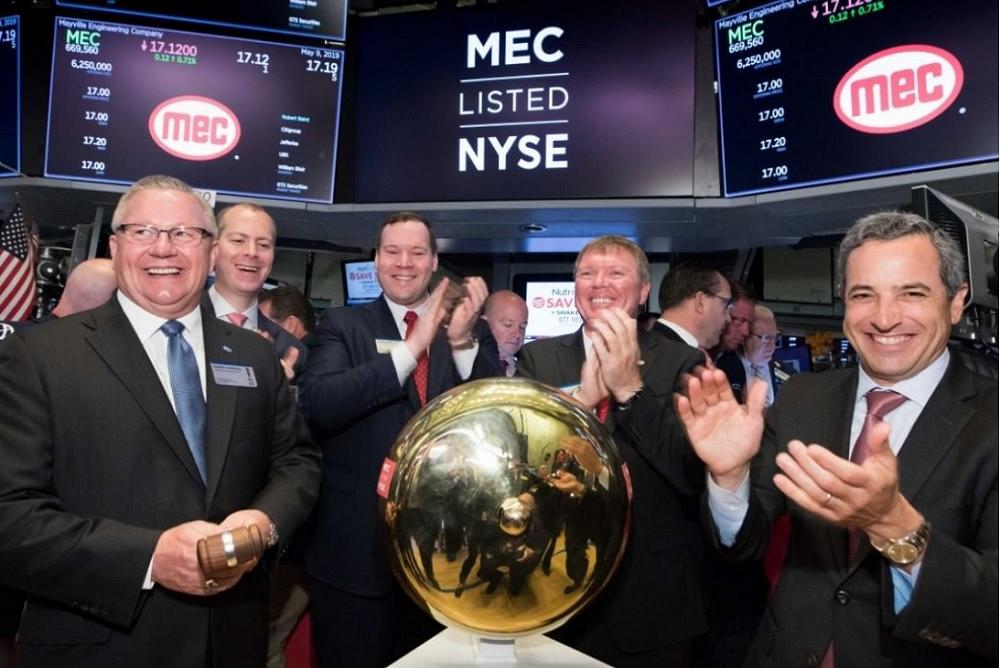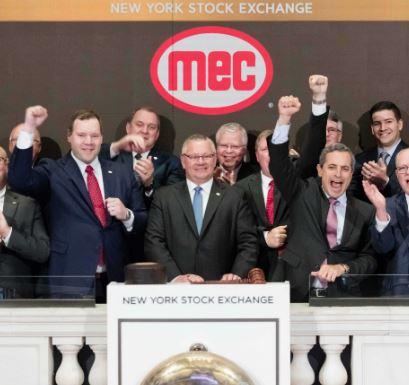Senior Editor
- FMA
- The Fabricator
- FABTECH
- Canadian Metalworking
Categories
- Additive Manufacturing
- Aluminum Welding
- Arc Welding
- Assembly and Joining
- Automation and Robotics
- Bending and Forming
- Consumables
- Cutting and Weld Prep
- Electric Vehicles
- En Español
- Finishing
- Hydroforming
- Laser Cutting
- Laser Welding
- Machining
- Manufacturing Software
- Materials Handling
- Metals/Materials
- Oxyfuel Cutting
- Plasma Cutting
- Power Tools
- Punching and Other Holemaking
- Roll Forming
- Safety
- Sawing
- Shearing
- Shop Management
- Testing and Measuring
- Tube and Pipe Fabrication
- Tube and Pipe Production
- Waterjet Cutting
Industry Directory
Webcasts
Podcasts
FAB 40
Advertise
Subscribe
Account Login
Search
MEC rings in its first day of trading
Custom metal fabricator raises $105 million from IPO
- By Tim Heston
- May 10, 2019

MEC CEO Bob Kamphuis, left, celebrates after ringing the opening bell at NYSE on May 9, the company's first day as a public company. (Photos provided by MEC)
If you turned on financial cable news the morning of May 9, you would have witnessed a first: A custom metal fabricator CEO, Bob Kamphuis, ringing the opening bell at the New York Stock Exchange. MEC had its initial public offering with an opening share price of $17, raising more than $105 million for the company. Employees, who were given shares under MEC's employee stock ownership plan (ESOP), will keep the shares they have; now, of course, MEC shares will be also available to the public.
“Employees continue to have a stake in the company,” Kamphuis told Yahoo! Finance, standing on the floor of the NYSE a few hours after ringing the opening bell. “The only difference is, now there’s a public marker [for the price] versus an annual valuation process. So now they’ll see how we compete at a new level in the capital markets. And I think we’re going to do very well.”
So why go public now? As Kamphuis explained in an interview with The FABRICATOR, “We’ve grown the value of MEC significantly since we became an ESOP in 1985 in Mayville, Wis., and we have a concentration of shares in Mayville. And retiring baby boomers puts a dent in our repurchasing obligation.”
When longtime workers retire from an ESOP, they’re required to sell their shares—and because the value of those shares has grown significantly, these transactions take a lot of cash. “The proceeds from the IPO put our balance sheet in a very conservative position.”
As a public company, MEC workers now have more options upon retirement. They no longer have to sell their shares back to the company; they instead can either hold on to the shares or sell them on the public market.
There’s good reason that employees might want to hold on to those shares.
“We saw practically every market we serve go in a positive trajectory,” said Ryan Raber, executive vice president, sales & marketing, performance structures and tanks. “As we get into 2019, similar conditions continue. The heavy-duty truck market continues at a record level, medium-duty continues to do well, the construction market is good, and agricultural equipment is on the upside, and the military equipment business has a bright future. Same thing goes for the power sports and recreation market.”
Another good reason to hold on to those shares: A massive acquisition that closed in December has also gone smoothly. According to SEC filings, MEC purchased Defiance, Ohio-based Defiance Metal Products for $115 million. “This acquisition was like getting a Christmas present, opening it, and seeing that there’s no assembly required and the batteries are included,” Kamphuis said. “It’s just a really good business, and we’re pleased to have them as part of our team.”
According to SEC filings, MEC purchased Defiance for about $115 million. The move further diversifies MEC’s customer base. But as sources explained, achieving revenue diversity isn’t just a matter of tackling new markets and buying companies with complementary customer bases. The competitive position of those customers in various markets really matters. Building a relationship with the top players in each market can help further reduce the peaks and valleys of the business cycle.
“During a recession, the Nos. 1 and 2 players in a market fall less than the Nos. 3 and 4 players,” Kamphuis said, adding that MEC identifies top players not only by market share, but by other factors too. “Who has the most dealers out there, and who has the best parts programs out there?” Heavy machinery, be it farm equipment or anything else, still needs repair parts even during the worst of an economic cycle, and MEC wants to be ready to provide those parts.
More customers in more markets also increases the complexity of the demand cycles and the associated capacity planning. “If you’re in numerous markets, now you also have to offer an agile, redeployable manufacturing capability," Kamphuis said, "so you can shift when you need to and keep the revenue streams steady.”
For long-term investors, that’s very good news indeed.
subscribe now

The Fabricator is North America's leading magazine for the metal forming and fabricating industry. The magazine delivers the news, technical articles, and case histories that enable fabricators to do their jobs more efficiently. The Fabricator has served the industry since 1970.
start your free subscriptionAbout the Author

Tim Heston
2135 Point Blvd
Elgin, IL 60123
815-381-1314
Tim Heston, The Fabricator's senior editor, has covered the metal fabrication industry since 1998, starting his career at the American Welding Society's Welding Journal. Since then he has covered the full range of metal fabrication processes, from stamping, bending, and cutting to grinding and polishing. He joined The Fabricator's staff in October 2007.
Related Companies
- Stay connected from anywhere

Easily access valuable industry resources now with full access to the digital edition of The Fabricator.

Easily access valuable industry resources now with full access to the digital edition of The Welder.

Easily access valuable industry resources now with full access to the digital edition of The Tube and Pipe Journal.
- Podcasting
- Podcast:
- The Fabricator Podcast
- Published:
- 04/16/2024
- Running Time:
- 63:29
In this episode of The Fabricator Podcast, Caleb Chamberlain, co-founder and CEO of OSH Cut, discusses his company’s...
- Trending Articles
Tips for creating sheet metal tubes with perforations

JM Steel triples capacity for solar energy projects at Pennsylvania facility

Are two heads better than one in fiber laser cutting?

Supporting the metal fabricating industry through FMA

Omco Solar opens second Alabama manufacturing facility

- Industry Events
16th Annual Safety Conference
- April 30 - May 1, 2024
- Elgin,
Pipe and Tube Conference
- May 21 - 22, 2024
- Omaha, NE
World-Class Roll Forming Workshop
- June 5 - 6, 2024
- Louisville, KY
Advanced Laser Application Workshop
- June 25 - 27, 2024
- Novi, MI



























